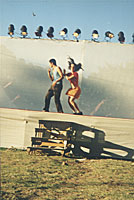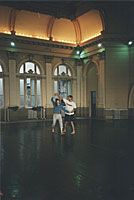Argentina is going through the biggest economic and political crises ever. Many Argentineans assured me that I was visiting the country in a "historical moment". Everybody is very worried about their uncertain future and their lack of perspectives. This very profound uncertainty and the fears connected to their every day survival is dominating every day life of Argentinean people but is also appearing in the cultural life of Argentina. The theatres and cinemas in Buenos Aires are booming, a lot of them are sold out every night. The little money that remained in people's pockets is strangely enough not only spent basic needs but as well in entertainment and culture. I can only assume that people feel a need to see and hear something that is distracting them or is talking about the fears and nightmares of everybody in this country. Something that is treating the realities of this country but through artistic means. In the most difficult moments art seems to transmit hope, the dream of something else. It is talking about what happens in the streets, is naming all those horrible thoughts that turn in everybody's heads day and night. Every spoken word on a stage, every allusion has an explosive effect. At the theatre the audience and the artists are sharing their questions and fears and maybe feeling less lonely.
This phenomenon can be transmitted on dance too. Even a very banal theme is becoming a statement about the living situation. Despite huge financial problems, dancers are taking classes and are preparing new work. Paid work is very rare anyway and surviving is difficult for everybody. Maybe dancing can help not to loose faith.
Modern dance came from Europe and later from USA to Argentina. The immigrants have very much influenced the development of dance. During the 20th century there have been many of the most important and well-known dancers and choreographers visiting Argentina, among others Les Ballets Russes, Anna Pavlova, Maurice Béjart, Pina Bausch. Nowadays the International Festival for Dance and Theatre had until last year the means to invite companies from overseas. The edition of 2003 is in preparation but nobody knows if in October 2003 there will be enough money and political will to carry it out.
An important step in the development of Modern Dance in Argentina was the foundation of the Ballet Contemporáneo del Teatro San Martín in Buenos Aires in 1977. Together with this contemporary ballet company (during some years directed by Oscar Araïz) a school for Modern Dance was founded at Teatro San Martín too. An important number of the dancers and choreographers that are working in and out of Argentina today graduated from this school.
The number of freelanced companies and choreographers in Buenos Aires has multiplied as in other parts of the world. I can mention here only of few of them:
- Nucleodanza is not as active as it used to be. In the 80ties the company directed by Margarita Bali and Susana Tambutti was touring extensively all around the world. The two directors are now choreographing less for their company but they are working in many ways for the development of dance and cultural politics in Argentina and they are both teaching in Argentina and abroad.
- Roxana Grinstein was recently invited to work on a production with Theater an der Sihl in Zurich. In Buenos Aires she is working with her company and directing her own theatre space and dance studio.
- The most successful younger choreographer is Brenda Angiel with her Aerial Dance technique. Her dancers are literally dancing in the air. This produces an unexpected change of perspectives and her choreographies seem to be very light and free. They are developing more and more into perfect and astonishing shows.
- The choreographer and dancer Gustavo Lesgart doesn’t know boundaries. He is working as much in Argentina as in Europe. He is dancing in different companies and also producing his own work since 1994 together with Inès Sanguinetti (Compañia Lesgart - Sanguinetti). He was recently invited to join the so-called X-Group of P.A.R.T.S. in Brussels. His work is not only well received in Argentina, this year his company is invited at Tanz im August in Berlin.
- Susana Szperling has been living in New York for five years. She was dancing for different American choreographers and studied Release Technique with the Trisha Brown. In her own choreographies as for example "inflamable" or "Rosita’s daughter" she is introducing her very special and own fantstic world. It could maybe be compared to the "magic reality" that appears in Latin-American movies and literature. Her last piece was based on the book of imaginary beings by Jorge Luis Borges.
- The two Argentinean ballet stars Julio Bocca and Maximiliano Guerra have both founded their own junior ballet companies in Buenos Aires. They support young Argentinean choreographers by inviting some of them as guest choreographers. The two companies are very successful and earn an important part of their budget through international touring.
Until last year the CoCoA (Coreógrafos Contemporáneos Asociados) was very active. Supported by the ministry of culture and the city of Buenos Aires the association invited internationally acclaimed guest teachers (i.e. Julyen Hamilton, Meg Stuart, Izok Kovacs) and every second year they organized a festival for contemporary dance in Buenos Aires. Due to the difficult political and economic situation and the nomination of a new responsible person in the ministry of culture it is unfortunately no longer possible to continue these events. There is still some hope that the necessary structures for independent dance are not disappearing completely during the next months. I wish the Argentinean dancers that they will find the energy during these hard times to continue and rebuild some of their achievements.
Independent dance in Argentina exists despite the crisis. I saw rehearsals in living rooms. I saw tango dancers researching since months and trying to redefine the contact between man and woman. The largest Contact-Improvisation-Community you can find in the world is in Buenos Aires. There are jams every day and once a month about 100 "contactors" are coming together in a big hall. But in everyday life dancing is very present too. Of course the world’s famous’ Milongas are in Buenos Aires, the every night meeting point of the tango addicts. On the countryside the folklore dances are very popular. On Sundays at popular markets people dance "Chacarera", "Cumbia" and "Samba" on the streets and everybody is welcome to join.
Bettina Holzhausen, July 2002
In July 2002 Bettina Holzhausen was invited to teach contemporary dance and improvisation / composition at University of Buenos Aires at the Centro Cultural Ricardo Rojas and at the University of Cordoba.


